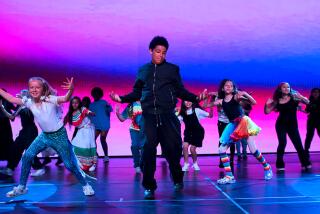Dancing to His Own Beat : After a mid-life crisis, Fred Strickler has found satisfaction as a teacher and choreographer
Four years ago dancer/choreographer Fred Strickler was feeling desperate about his life.
“I wasn’t happy or satisfied with how I was operating in the world, even though I was having very good success as an artist,” said the 46-year-old former Jazz Tap Ensemble dancer who is noted for his silken approach to percussive rhythms.
“People were bursting into applause, having a great time and everyone loved it but me. There were times,” he said, “when I would go on stage and I would be in a rage. I finally said to myself, ‘What’s wrong with this picture?’ ”
Strickler--who followed his bachelor of science and education degree in dance from Ohio State University in 1966 by combining teaching at UC Riverside with a career in professional dance in Bella Lewitzky’s company and later as a co-founder of the experimental modern Eyes Wide Open Dance Theatre (1974) and Jazz Tap Ensemble (1979)--was unable to pin down the exact reasons for his mid-life crisis.
He left Jazz Tap Ensemble in 1986 because he felt the need to do his own work and to perform modern dance. He also explored the Hindu beliefs of Krishnamurti, the works of the late mythologist Joseph Campbell and then learned practical ways to change his life through a self-help program called Life Spring.
“For me it was discovering how to make my life as a teacher and performer work. I’ve found that what works for me is to be open and to respond to things, not to just react to them,” said the current chairman of the UC Riverside Dance Department. He will present “my very first evening of my choreography” with works that include tap, modern and ballet at Santa Monica College’s Studio Stage, Jan. 5 and 6.
“I now have the tools for dealing with myself and dealing with my relationships,” Strickler said.
As a result, his dances “are not literal. They are abstractions, metaphors.”
A duet titled “Between Friends” exemplifies the way Strickler uses responsive feelings to build a dance choreographically. He created the piece for himself and Victoria Keonig of L.A. Chamber Ballet, and it will be danced by Keonig and former Laura Dean dancer Paul Maillard at Santa Monica College in a program that includes three premieres and live music.
“I rarely start out with a topic, but something emerges. When Vickie asked me to do this, we didn’t know each other very well. I didn’t have any specific ideas. I was terrified about the idea of working with a ballerina of her caliber, because I don’t consider myself a ballet dancer,” he said.
Strickler and Keonig started the piece with “no music and no agenda--no ideas. We worked in the studio for three or four months and I feel the dance was really about getting to know each other, and those movements came together to illuminate that friendship.”
Strickler’s approach to his choreography extends to his teaching method, a Socratic sharing of ideas in an open forum.
“When I walk into a choreography class the first thing I write on the board is that ‘there are no rules,’ ” he said. “I think good teaching is the empowering of the student, not the overpowering.”
Strickler encourages his students to discover their choreographic bent by creating dance for 45 minutes without ceasing motion.
“It’s an exercise and there can be no stillness, only motion. After they get exhausted and run out of ideas, and they don’t know what to do next, that’s when the discovery begins, that’s when the body knowledge which is very deep and nonverbal begins to emerge and some fascinating things occur. This is about problem solving, discovering new possibilities. You show students that this is a way of going deeper into themselves, going ahead with their ideas, trusting themselves and experiencing success,” he said. “I feel I’ve succeeded if my students discover what their deep feelings are, their sensations and their sensibilities.”
Strickler treats his audiences in the same fashion. “I think it’s important to make dances that don’t close out my audience. I’m not interested in being didactic. I try to make dances that allow people to find themselves in my work. To me that’s what dance is about, communication through movement.”
More to Read
The biggest entertainment stories
Get our big stories about Hollywood, film, television, music, arts, culture and more right in your inbox as soon as they publish.
You may occasionally receive promotional content from the Los Angeles Times.










